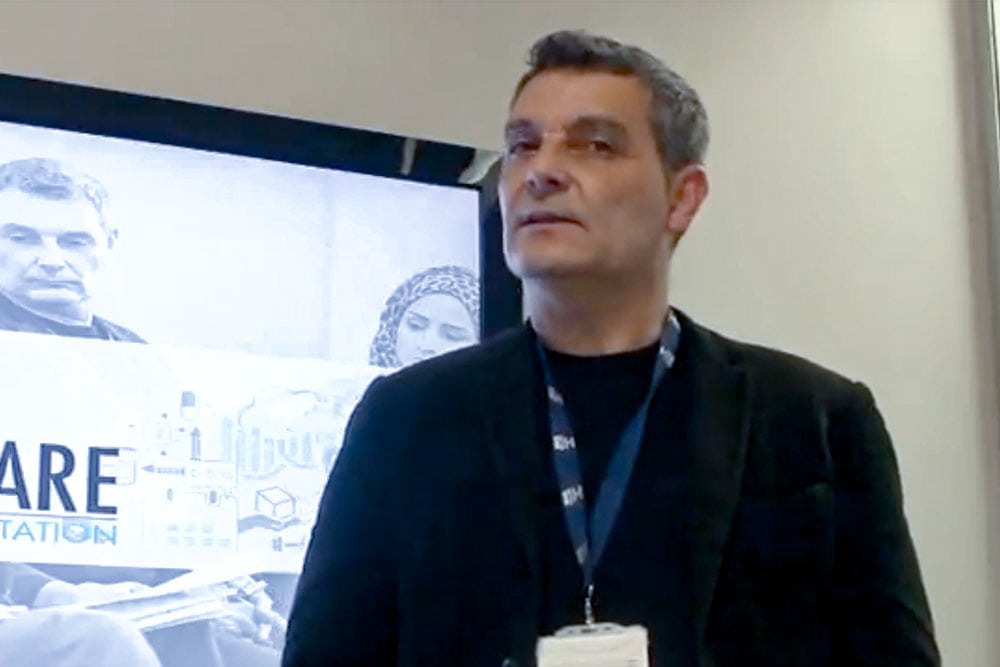Scotland has a new license for a national approach to driving digital innovation, NHS Education for Scotland digital director Christopher Wroath tells Matthew D’Arcy.
“Once for Scotland,” was the message sent by Scotland’s health and local government leaders when they published the landmark Digital Health and Social Care Strategy this year.
For Christopher Wroath, this “top of the chain” statement is a mandate that will shift thinking from a health board or regional level to a national level.
It will mean standardised data access, delivering more services in users’ homes, and the creation of a “digital ecosystem” in which innovations and technology can flourish at scale across the country.
“Chief executives in the NHS have recognised that in the realm of modern technology they need to think about a national service that will be implemented at national and local level,” he says. “Thinking of the NHS as a single entity in the context of technology is going to be the key to it all.”
Giving up power, ending ‘splendid isolation’
Wroath is no stranger to the complexities of public services, politics and technology. He led services at Number 10 and the Cabinet Office, and was the last-ever IT director at Whitehall’s Central Office of Information, which closed its doors in March 2012 after a 65-year history.
He is now digital director at NHS Education for Scotland, a health board that will play a central role in developing the workforce capabilities set out in the new strategy. Earlier this year, he received the inaugural Digital Leader Award from Holyrood Connect, sponsored by InterSystems, in recognition of ongoing work to improve recruitment, retention and the NHS working experience.
It is Scotland’s digital leaders who have now been given the appropriate structure to lead transformation beyond the “splendid isolation” of individual health boards, says Wroath. “I’m not saying that is easy. Giving up power is not going to be a natural process for boards, but I think there is a recognition it is necessary.”
Building on the past
Scotland is no stranger to ambitious, public service technology strategies. Almost a decade ago, it published a 2011-2017 eHealth Strategy focussed on improving the availability of information for healthcare workers.
This was refreshed by the Scottish government in 2014, in recognition of a strategic intent for integrated health and social care. But with ‘eHealth’ as a clue in the title, the strategy retained a significant focus on the needs of the NHS in Scotland.
At the same time, the implementation of the strategy has tended to happen one health board at a time; leading to a lack of integration and claims from some individuals that Scotland has suffered from a heavy case of ‘pilotitis’.
Wroath says it has been clear something more has been needed. “There has been a need for strategic direction. We were hamstrung by an eHealth Strategy. Now we have been liberated by a Digital Health and Social Care Strategy. You will see a lot of people who previously didn’t feel they had a license to move into the digital space who are prepared to go there now.”
Not about data sharing
A new national approach implies single clinical models, single data models and “a whole bunch of convergence”, he says. Working out information governance is a key focus of the strategy, with commitment from the Scottish government to overcome variations in approach.
By 2020, it has promised to deliver “a simplified and consistent national approach for information assurance which will take into account the different needs of users and citizens, and provide clarity around information sharing across health and care.”
Wroath believes such standard approaches will ultimately allow leaders to focus on challenges that go beyond just sharing data, and get into what can be done with it. “It is not about sharing data, it is about access to data. Data should stay where it is in the future,” he says.
Key will be widespread adoption of cloud technology, empowering conformity and service redesign. “Cloud technology means geography is irrelevant to how that service is delivered. With older technologies you have got to be in the hospital, or in the GP surgery to be on the same network. With cloud you are not constrained by geography, you can be wherever you need to be.”
This is the simple focus that must not be drowned out by technical challenges. “We collect information, we store information, and we present information effectively and securely to the right care professional whenever they need it, wherever they are,” says Wroath.
“When we don’t have all the usual stress of data sharing protocols, and all of the need to recode, then we can stop focussing on the complexity of the technology and start focussing on making sure the things we want to procure are adding real value to the services we are trying to provide to the service users – the people of Scotland.”
A digital ecosystem of the future
Scotland does have some national foundations to build on. Nearly all of Scotland’s 14 regional health boards have adopted InterSystems TrakCare health information system, whilst national procurements have helped to proliferate other core clinical technologies.
But high profile parliamentary reports have suggested the country has a long way to go when it comes to adopting many “cutting edge” technologies. Wroath says one of the answers is that new digital ecosystem. “We need to create a marketplace where vendors can just plug things in and it works.”
He also argues that setting clear expectations to the market will be good for suppliers. “There is lots of innovation around, but getting it scaled up is really hard because there isn’t a cohesive set of standards in and around the way that things need to ‘plug into the system’,” he says.
“We need to work quickly on our statement of standards for suppliers, so we can say: ‘If your products adhere to these; then you will be plugging into the ecosystem’.”
He also argues that this will be good for the public purse, and that: “We need to be able to leverage money that we spend with suppliers and vendors much more effectively than we have done previously.”
Closer UK ties
Maximising how money is spent will require wider collaboration, he adds. “We need to work very closely and collaboratively with NHS Digital, NHS England and our colleagues in Wales and Northern Ireland too, to make sure we are all singing off the same hymn sheet.
“I have been working with those organisations to do exactly that – to make sure we have a UK approach to these things. That is the only way we can work effectively with the private sector.
“Cloud services means we are going to be buying products and services, rather than working with old style systems integrator models. We need to be much more flexible about how we work with the private sector, and the private sector needs to be much more responsive to our needs.”
Scotland as an exemplar
However, Wroath feels Scotland has an opportunity to surpass its UK counterparts. It has already achieved significant consolidation of systems in hospitals, GP surgeries and other settings, and has a population that looks ideally suited for modern, data-driven planning and prevention approaches.
“Scotland is in a ‘Goldilocks’ place – it is big enough for this to be meaningful, with 5.6 million people, but not so big that you are dealing with unmanageable numbers,” says Wroath. “Trying to treat the NHS in England as an enterprise is really challenging. In Scotland, you can. That is a massive advantage.
“In Scotland the 14 [health boards] are becoming one in the context of technology. The ‘once for Scotland’ approach is a recognition that you need to have an approach for populations [of around] 5.6 million. We are just the right size, so hopefully we can leverage success for the rest of the UK. We have an opportunity to be an exemplar.”



